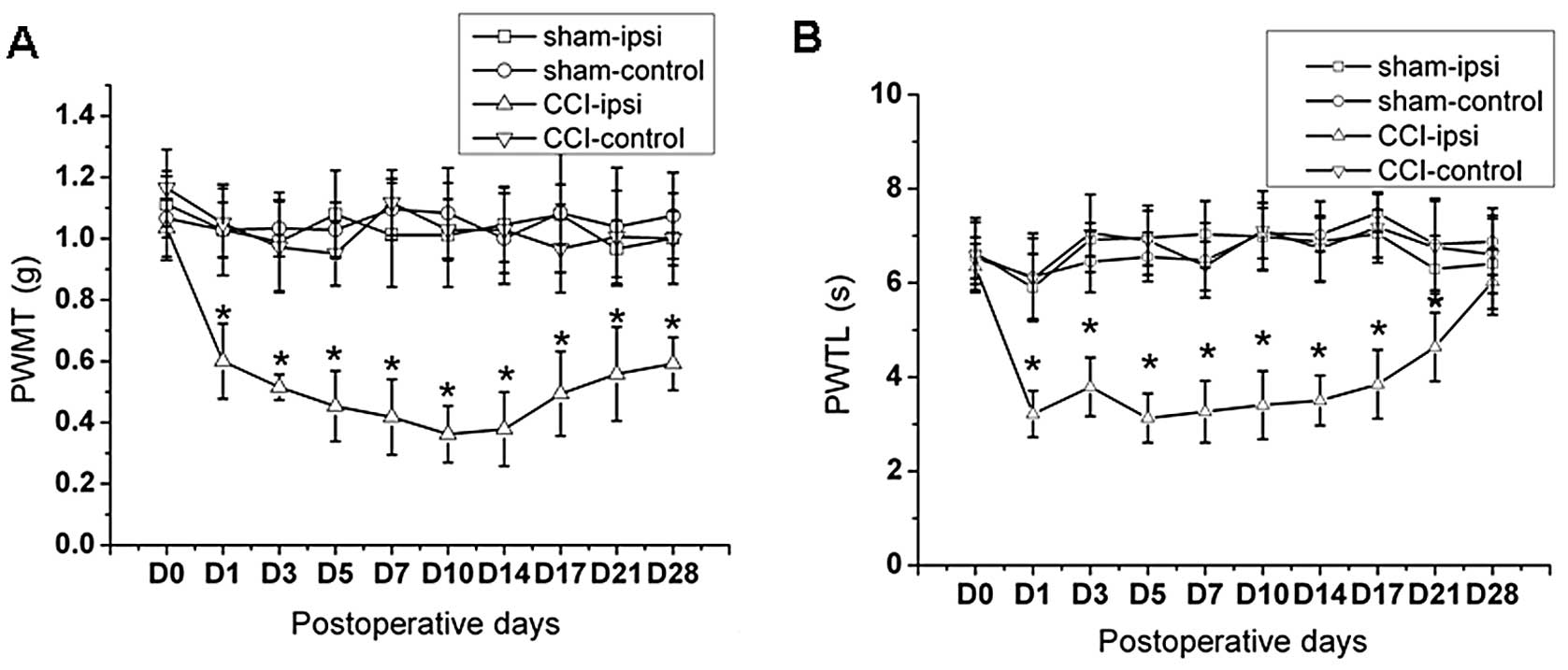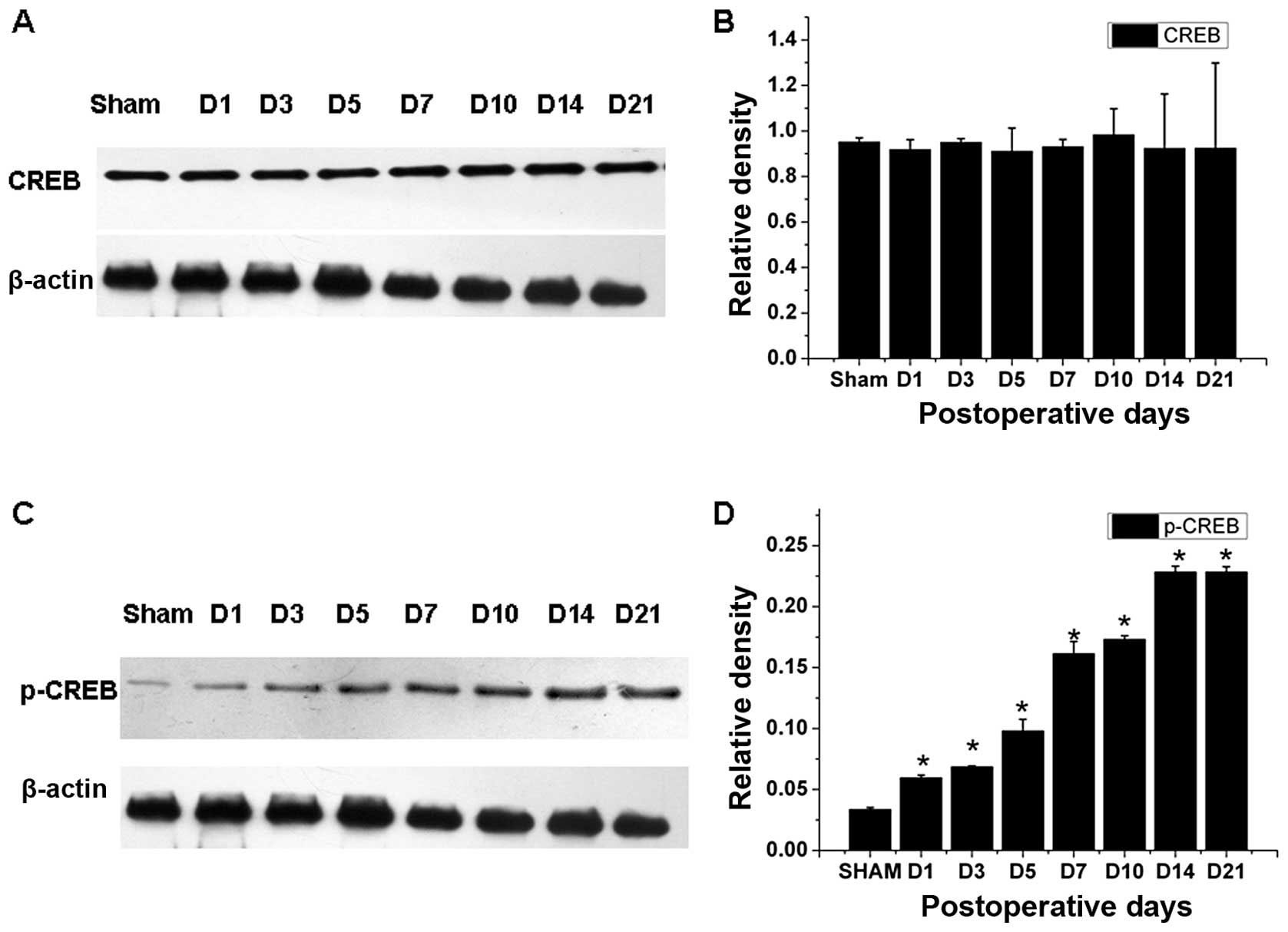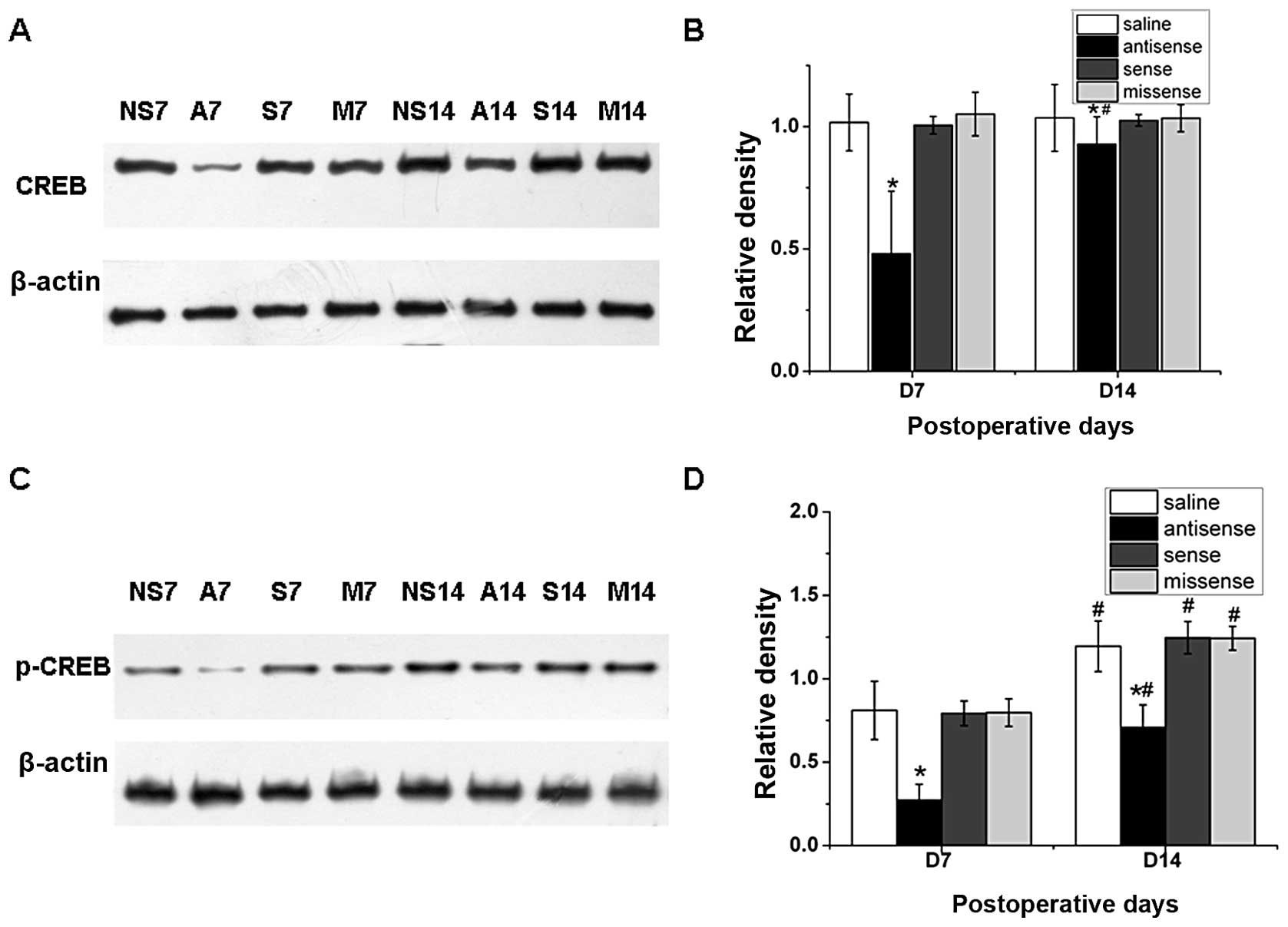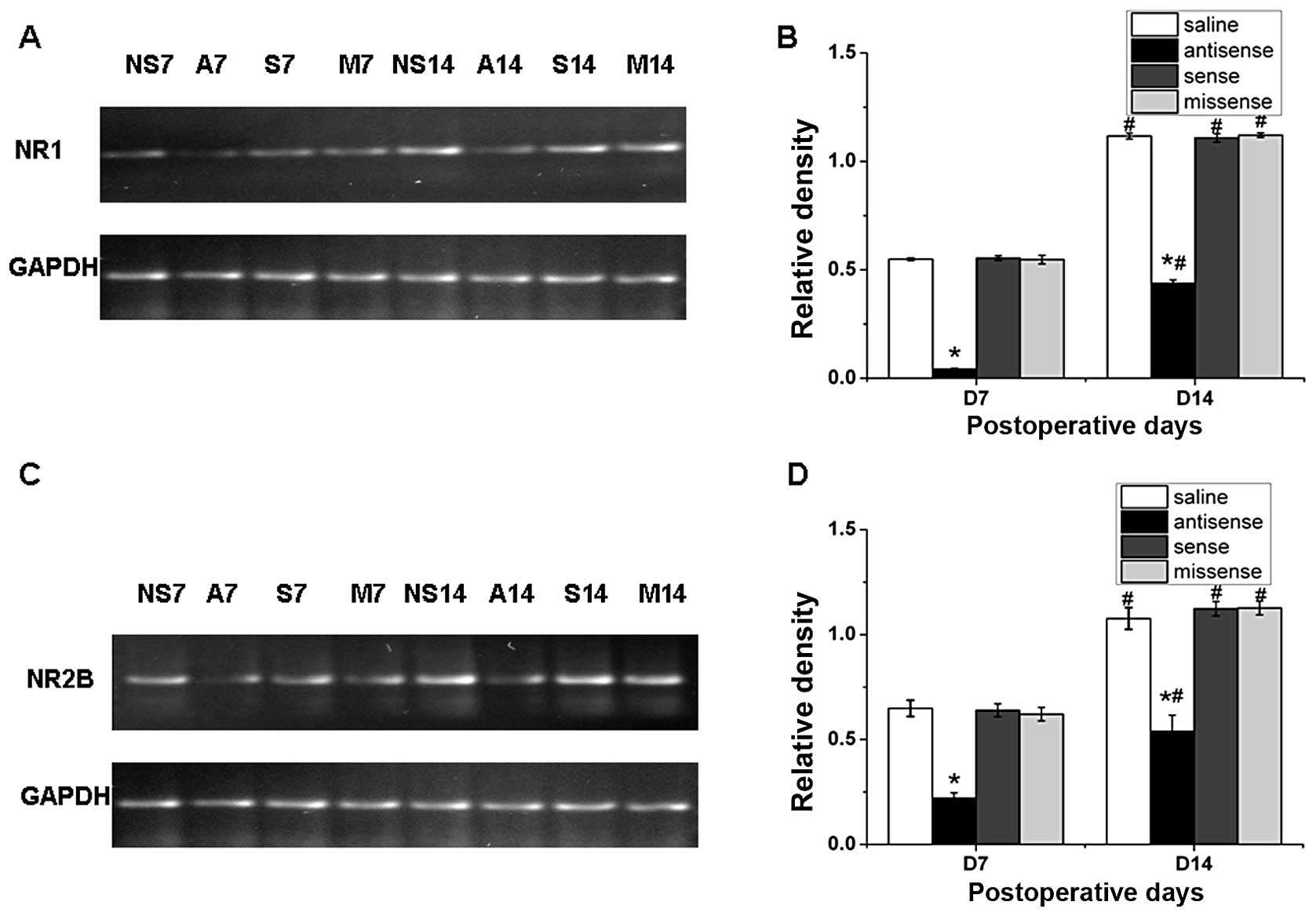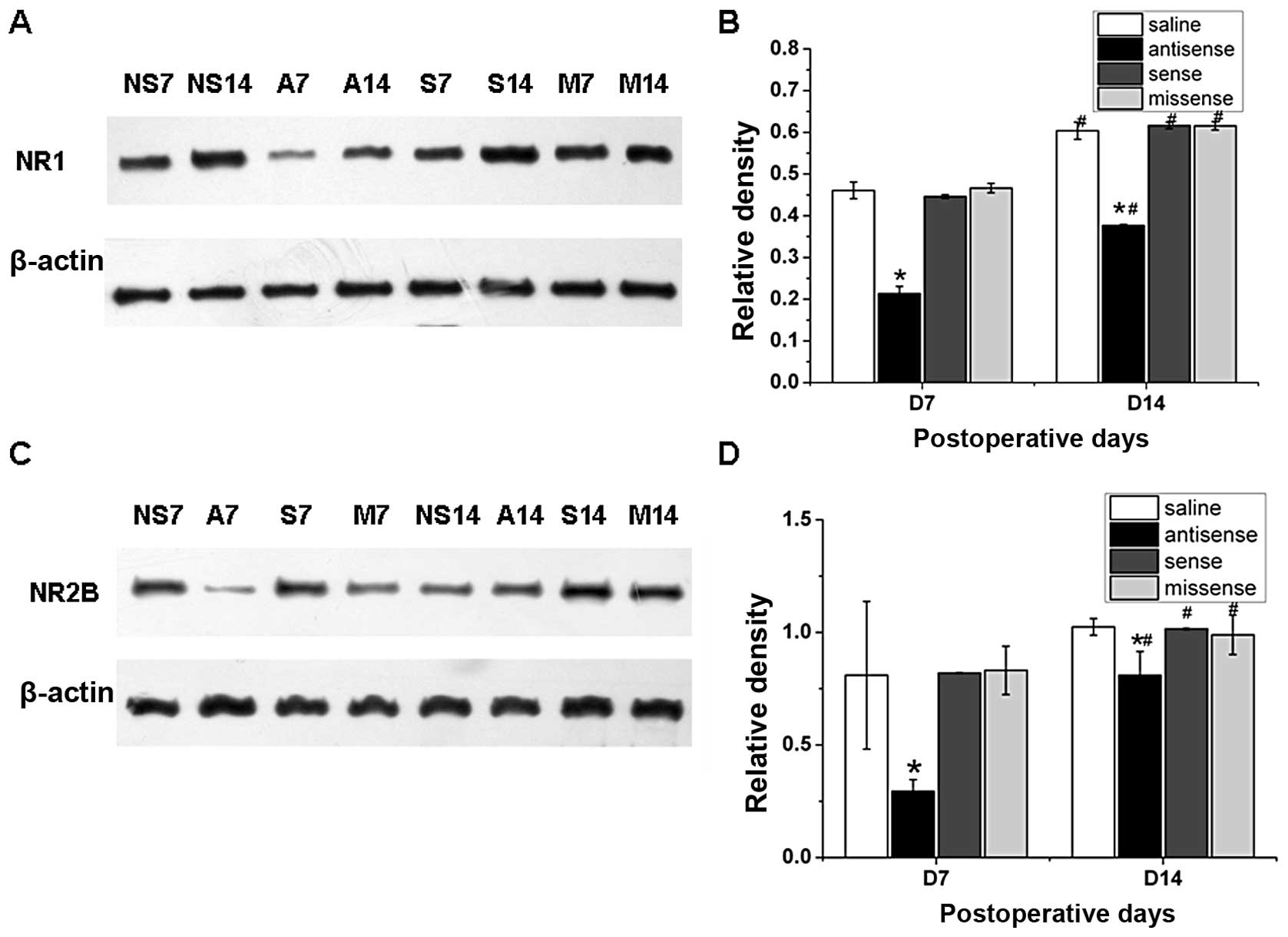|
1
|
Ma W, Hatzis C and Eisenach JC:
Intrathecal injection of cAMP response element binding protein
(CREB) antisense oligonucleotide attenuates tactile allodynia
caused by partial sciatic nerve ligation. Brain Res. 988:97–104.
2003. View Article : Google Scholar
|
|
2
|
Wang YY, Wu SX, Zhou L, Huang J, Wang W,
Liu XY and Li YQ: Dose-related antiallodynic effects of cyclic AMP
response element-binding protein-antisense oligonucleotide in the
spared nerve injury model of neuropathic pain. Neuroscience.
139:1083–1093. 2006. View Article : Google Scholar
|
|
3
|
Messersmith DJ, Kim DJ and Iadarola MJ:
Transcription factor regulation of prodynorphin gene expression
following rat hindpaw inflammation. Brain Res Mol Brain Res.
53:260–269. 1998. View Article : Google Scholar : PubMed/NCBI
|
|
4
|
Anderson LE and Seybold VS: Phosphorylated
cAMP response element binding protein increases in neurokinin-1
receptor-immunoreactive neurons in rat spinal cord in response to
formalin-induced nociception. Neurosci Lett. 283:29–32. 2000.
View Article : Google Scholar
|
|
5
|
Ma W and Quirion R: Increased
phosphorylation of cyclic AMP response element-binding protein
(CREB) in the superficial dorsal horn neurons following partial
sciatic nerve ligation. Pain. 93:295–301. 2001. View Article : Google Scholar : PubMed/NCBI
|
|
6
|
Miletic G, Pankratz MT and Miletic V:
Increases in the phosphorylation of cyclic AMP response element
binding protein (CREB) and decreases in the content of calcineurin
accompany thermal hyperalgesia following chronic constriction
injury in rats. Pain. 99:493–500. 2002. View Article : Google Scholar
|
|
7
|
Wang Y, Cheng X, Xu J, Liu Z, Wan Y and Ma
D: Anti-hyperalgesic effect of CaMKII inhibitor is associated with
downregulation of phosphorylated CREB in rat spinal cord. J Anesth.
25:87–92. 2011. View Article : Google Scholar : PubMed/NCBI
|
|
8
|
Hoeger-Bement MK and Sluka KA:
Phosphorylation of CREB and mechanical hyperalgesia is reversed by
blockade of the cAMP pathway in a time-dependent manner after
repeated intramuscular acid injections. J Neurosci. 23:5437–5445.
2003.PubMed/NCBI
|
|
9
|
Ji RR and Rupp F: Phosphorylation of
transcription factor CREB in rat spinal cord after formalin-induced
hyperalgesia: relationship to c-fos induction. J Neurosci.
17:1776–1785. 1997.PubMed/NCBI
|
|
10
|
Zimmermann M: Ethical guidelines for
investigations of experimental pain in conscious animals. Pain.
16:109–110. 1983. View Article : Google Scholar : PubMed/NCBI
|
|
11
|
Wu WP, Xu XJ and Hao JX: Chronic lumbar
catheterization of the spinal subarachnoid space in mice. J
Neurosci Methods. 133:65–69. 2004. View Article : Google Scholar : PubMed/NCBI
|
|
12
|
Bennett GJ and Xie YK: A peripheral
mononeuropathy in rat that produces disorders of pain sensation
like those seen in man. Pain. 33:87–107. 1988. View Article : Google Scholar
|
|
13
|
Klein M, Pieri I, Uhlmann F, Pfizenmaier K
and Eisel U: Cloning and characterization of promoter and 5′-UTR of
the NMDA receptor subunit epsilon 2: evidence for alternative
splicing of 5′-non-coding exon. Gene. 208:259–269. 1998.
|
|
14
|
Lau GC, Saha S, Faris R and Russek SJ:
Up-regulation of NMDAR1 subunit gene expression in cortical neurons
via a PKA-dependent pathway. J Neurochem. 88:564–575. 2004.
View Article : Google Scholar : PubMed/NCBI
|
|
15
|
Rani CS, Qiang M and Ticku MK: Potential
role of cAMP response element-binding protein in ethanol-induced
N-methyl-D-aspartate receptor 2B subunit gene transcription in
fetal mouse cortical cells. Mol Pharmacol. 67:2126–2136. 2005.
View Article : Google Scholar : PubMed/NCBI
|
|
16
|
Yin X, Takei Y, Kido MA and Hirokawa N:
Molecular motor KIF17 is fundamental for memory and learning via
differential support of synaptic NR2A/2B levels. Neuron.
70:310–325. 2011. View Article : Google Scholar : PubMed/NCBI
|
|
17
|
Guzowski JF and McGaugh JL: Antisense
oligodeoxynucleotide-mediated disruption of hippocampal cAMP
response element binding protein levels impairs consolidation of
memory for water maze training. Proc Natl Acad Sci USA.
94:2693–2698. 1997. View Article : Google Scholar
|
|
18
|
Edoff K, Grenegard M and Hildebrand C:
Retrograde tracing and neuropeptide immunohistochemistry of sensory
neurones projecting to the cartilaginous distal femoral epiphysis
of young rats. Cell Tissue Res. 299:193–200. 2000. View Article : Google Scholar
|
|
19
|
Nakanishi S: Molecular diversity of
glutamate receptors and implications for brain function. Science.
258:597–603. 1992. View Article : Google Scholar : PubMed/NCBI
|
|
20
|
Lau CG and Zukin RS: NMDA receptor
trafficking in synaptic plasticity and neuropsychiatric disorders.
Nat Rev Neurosci. 8:413–426. 2007. View
Article : Google Scholar : PubMed/NCBI
|
|
21
|
Bai G and Kusiak JW: Cloning and analysis
of the 5′ flanking sequence of the rat N-methyl-D-aspartate
receptor 1 (NMDAR1) gene. Biochim Biophys Acta. 1152:197–200.
1993.
|
|
22
|
Yin JC and Tully T: CREB and the formation
of long-term memory. Curr Opin Neurobiol. 6:264–268. 1996.
View Article : Google Scholar : PubMed/NCBI
|
|
23
|
Mayr B and Montminy M: Transcriptional
regulation by the phosphorylation-dependent factor CREB. Nat Rev
Mol Cell Biol. 2:599–609. 2001. View
Article : Google Scholar : PubMed/NCBI
|
|
24
|
Carlezon WA, Duman RS and Nestler EJ: The
many faces of CREB. Trends Neurosci. 28:436–445. 2005. View Article : Google Scholar : PubMed/NCBI
|
|
25
|
Ma ZL, Zhang W, Gu XP, Yang WS and Zeng
YM: Effects of intrathecal injection of prednisolone acetate on
expression of NR2B subunit and nNOS in spinal cord of rats after
chronic compression of dorsal root ganglia. Ann Clin Lab Sci.
37:349–355. 2007.PubMed/NCBI
|
|
26
|
Gu X, Yang L, Wang S, Sung B, Lim G, Mao
J, Zeng Q and Yang C: A rat model of radicular pain induced by
chronic compression of lumbar dorsal root ganglion with SURGIFLO.
Anesthesiology. 108:113–121. 2008. View Article : Google Scholar : PubMed/NCBI
|
|
27
|
Zhang W, Shi CX, Gu XP, Ma ZL and Zhu W:
Ifenprodil induced antinociception and decreased the expression of
NR2B subunits in the dorsal horn after chronic dorsal root ganglia
compression in rats. Anesth Analg. 108:1015–1020. 2009. View Article : Google Scholar : PubMed/NCBI
|
|
28
|
Gu X, Zhang J, Ma Z, Wang J, Zhou X, Jin
Y, Xia X, Gao Q and Mei F: The role of N-methyl-D-aspartate
receptor subunit NR2B in spinal cord in cancer pain. Eur J Pain.
14:496–502. 2010. View Article : Google Scholar : PubMed/NCBI
|
|
29
|
Storvik M, Linden AM, Kontkanen O, Lakso
M, Castren E and Wong G: Induction of cAMP response element
modulator (CREM) and inducible cAMP early repressor (ICER)
expression in rat brain by uncompetitive N-methyl-D-aspartate
receptor antagonists. J Pharmacol Exp Ther. 294:52–60.
2000.PubMed/NCBI
|
|
30
|
Lonze BE and Ginty DD: Function and
regulation of CREB family transcription factors in the nervous
system. Neuron. 35:605–623. 2002. View Article : Google Scholar : PubMed/NCBI
|
|
31
|
West AE, Griffith EC and Greenberg ME:
Regulation of transcription factors by neuronal activity. Nat Rev
Neurosci. 3:921–931. 2002. View
Article : Google Scholar : PubMed/NCBI
|
|
32
|
Huang YH, Lin Y, Brown TE, et al: CREB
modulates the functional output of nucleus accumbens neurons: a
critical role of N-methyl-D-aspartate glutamate receptor (NMDAR)
receptors. J Biol Chem. 283:2751–2760. 2008. View Article : Google Scholar : PubMed/NCBI
|
|
33
|
Jung WR, Kim HG, Shin MK, Park DI and Kim
KL: The effect of ganglioside GQ1b on the NMDA receptor signaling
pathway in H19-7 cells and rat hippocampus. Neuroscience.
165:159–167. 2010. View Article : Google Scholar
|
|
34
|
Zhuo M: Plasticity of NMDA receptor NR2B
subunit in memory and chronic pain. Mol Brain. 2:42009. View Article : Google Scholar : PubMed/NCBI
|
|
35
|
Gonzalez GA and Montminy MR: Cyclic AMP
stimulates somatostatin gene transcription by phosphorylation of
CREB at serine 133. Cell. 59:675–680. 1989. View Article : Google Scholar : PubMed/NCBI
|
|
36
|
Wang S, Lim G, Zeng Q, Sung B, Yang L and
Mao J: Central glucocorticoid receptors modulate the expression and
function of spinal NMDA receptors after peripheral nerve injury. J
Neurosci. 25:488–495. 2005. View Article : Google Scholar : PubMed/NCBI
|
|
37
|
Storvik M, Tiikkainen P, van Iersel M and
Wong G: Distinct gene expression profiles in adult rat brains after
acute MK-801 and cocaine treatments. Eur Neuropsychopharmacol.
16:211–219. 2006. View Article : Google Scholar : PubMed/NCBI
|
|
38
|
Konopka D, Szklarczyk AW, Filipkowski RK,
Trauzold A, Nowicka D, Hetman M and Kaczmarek L: Plasticity- and
neurodegeneration-linked cyclic-AMP responsive element
modulator/inducible cyclic-AMP early repressor messenger RNA
expression in the rat brain. Neuroscience. 86:499–510. 1998.
View Article : Google Scholar : PubMed/NCBI
|















